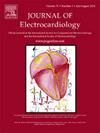The effect of use contrast medium on frontal plane QRS-T angle in patients who had elective coronary angiography
IF 1.3
4区 医学
Q3 CARDIAC & CARDIOVASCULAR SYSTEMS
引用次数: 0
Abstract
Background
Contrast medium used in coronary angiography may cause changes in the electrophysiological properties of the myocardium, which may lead to some changes in the electrocardiography (ECG). Frontal plane QRS-T (fQRS-T) angle, which can be easily calculated from surface ECG, is an indicator of ventricular repolarization heterogeneity and predictive of arrhythmia.
Aims
The aim of our study was to investigate the effect of contrast medium use on the fQRS-T angle in patients undergoing elective coronary angiography with the diagnosis of stable angina pectoris.
Methods
Our study included 343 patients diagnosed with stable angina pectoris who underwent elective coronary angiography. Demographic data and risk factors of all patients were recorded at admission. The frontal plane QRS-T angle was calculated from routine ECG recordings of patients included in the study before and after coronary angiography and the change was recorded. The amount of contrast agent used was also noted for each patient.
Results
The mean age of the patients included in the study was 57.03 ± 9.10, and 185 (53.9 %) were male. The change in fQRS-T angle was statistically significant after the use of contrast media (30.04 ± 30.76 vs 33.87 ± 32.6, p value <0.001).
Conclusions
In our study, although there was a statistically significant increase in the fQRS-T angle of the patients after contrast material, it did not exceed the pathological limit and no life-threatening ventricular arrhythmia was observed.
造影剂对择期冠状动脉造影患者额平面QRS-T角的影响
背景冠脉造影剂可引起心肌电生理特性的改变,从而引起心电图的改变。额平面QRS-T (fQRS-T)角是反映心室复极异质性的一个指标,可用于预测心律失常的发生。目的本研究的目的是探讨造影剂的使用对诊断为稳定型心绞痛的选择性冠状动脉造影患者fQRS-T角的影响。方法本研究纳入343例经择期冠状动脉造影诊断为稳定型心绞痛的患者。入院时记录所有患者的人口学资料及危险因素。根据纳入研究的患者冠状动脉造影前后的常规心电图记录计算额平面QRS-T角,并记录其变化。同时记录每位患者的造影剂用量。结果本组患者平均年龄为57.03±9.10岁,男性185例(53.9%)。使用造影剂后fQRS-T角度变化有统计学意义(30.04±30.76 vs 33.87±32.6,p值<;0.001)。结论在我们的研究中,虽然造影剂后患者的fQRS-T角度有统计学意义的增加,但未超过病理极限,未观察到危及生命的室性心律失常。
本文章由计算机程序翻译,如有差异,请以英文原文为准。
求助全文
约1分钟内获得全文
求助全文
来源期刊

Journal of electrocardiology
医学-心血管系统
CiteScore
2.70
自引率
7.70%
发文量
152
审稿时长
38 days
期刊介绍:
The Journal of Electrocardiology is devoted exclusively to clinical and experimental studies of the electrical activities of the heart. It seeks to contribute significantly to the accuracy of diagnosis and prognosis and the effective treatment, prevention, or delay of heart disease. Editorial contents include electrocardiography, vectorcardiography, arrhythmias, membrane action potential, cardiac pacing, monitoring defibrillation, instrumentation, drug effects, and computer applications.
 求助内容:
求助内容: 应助结果提醒方式:
应助结果提醒方式:


